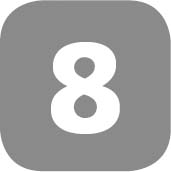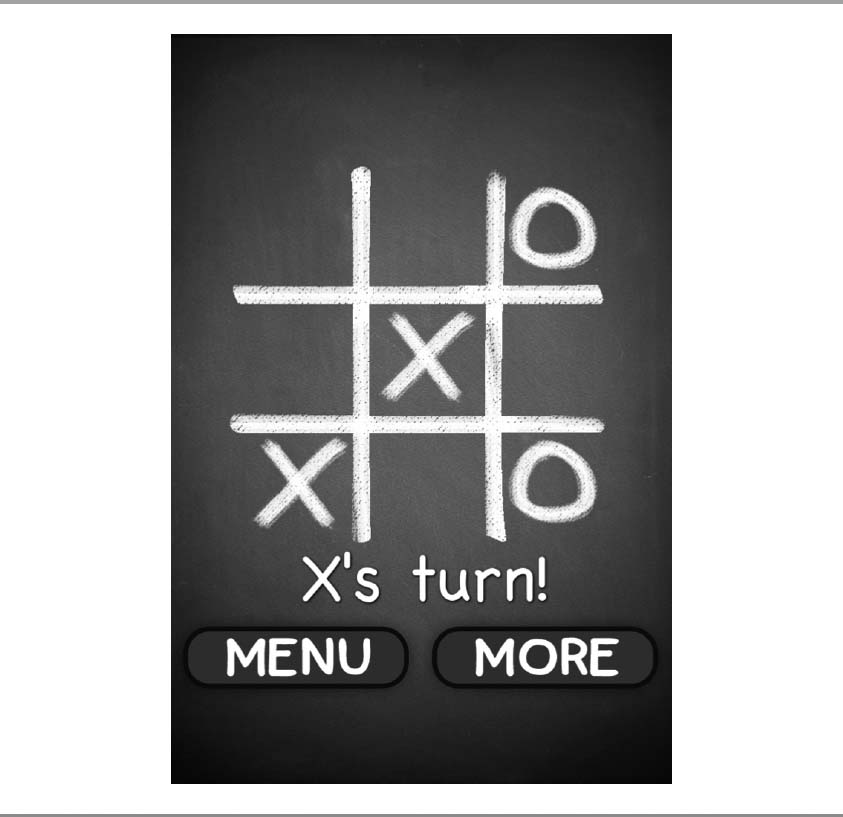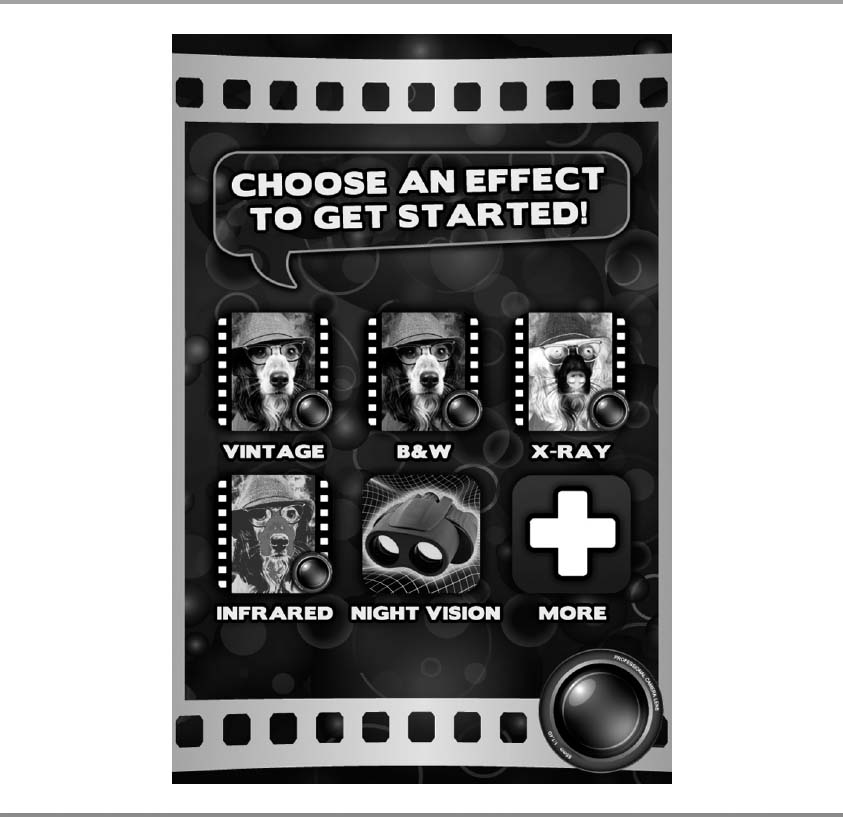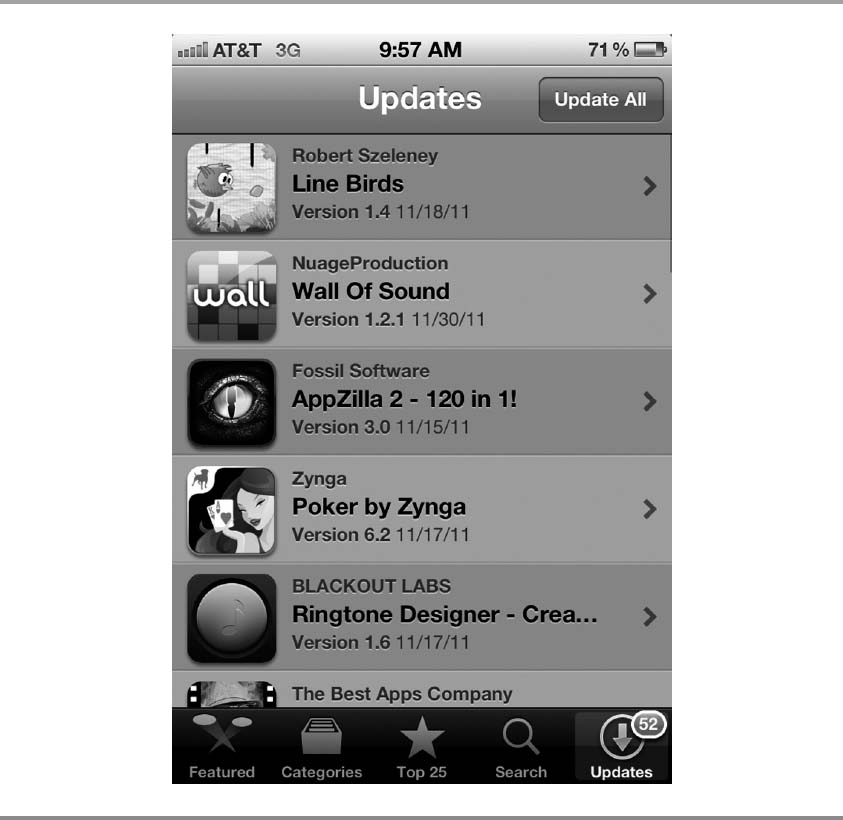Ninja Techniques that Will Grow Your Business
Advanced Marketing Tips and Tricks
Notice that the stiffest tree is most easily cracked, while the bamboo or willow survives by bending with the wind.
—Bruce Lee
Once I figured out that being able to market myself was essential, my confidence and ability to attract people soared. I felt as though I had discovered some type of superpower, and I was never going back. I went on a few dates and even ended up getting together with the beautiful blue-eyed girl, Vicky, whom I had struck out with at the freshman party. As we got to know each other, like at the start of any relationship, everything was new, exciting, and magical.
“I'm in love,” I proclaimed to my college roommate Jeffrey, who smirked and rolled his eyes. Without a warning, a few months in, things began to change. As the relationship got more serious, there were expectations we each had that the other wasn't meeting. The honeymoon was over. I needed to understand more to keep the relationship alive and thriving.
“What do I do now?” I asked my friends. Through multiple conversations they made me realize that it takes a different set of skills and a deeper level of understanding to keep a relationship going and take it to the next level. They were right. What had worked in the beginning wasn't enough anymore and I had to step up my game.
A similar pattern can happen in business as well. Initially, everything seems great because you experience immediate and significant growth when you start from zero. You attract a great customer base with your initial marketing. You see your traffic and income grow, and you think your growth spurt will never end. At some point, you hit a wall, and you watch as your business starts to plateau or drop off. As with any business, you can't become complacent with your initial success and must be open to implementing new strategies to keep your business strong.
In the app world, many advanced marketing strategies are available to attract new users and keep them coming back, upgrading, and spending more money.
Every technique I talk about in this chapter is designed to drive as much traffic as possible to your apps and keep them from stagnating. The beauty of these techniques is that most of them are free and don't necessarily require more time or effort. By using a few of these advanced tactics, you can catapult yourself from app newbie to app expert.
HITTING A PLATEAU
I knew the after party had ended for my first app as soon as I saw the numbers dropping for a week straight. I realized I had gotten complacent and had stopped experimenting with new marketing strategies because I had been making good money.
Taking the hint, I sprang into action but continued to see my numbers decline for about a month and a half. I tried strategies that had worked previously but to no avail. I watched, trying new things, as revenue dropped from more than $900 a day to about $300 a day. I was not about to give up and began testing a bunch of new strategies to generate more revenue. Every week, I would use a new marketing technique to see if I could invigorate my fading app.
Finally, after some trial and error, a few of these techniques worked, and the downtrend reversed. Two months later, I was consistently averaging more than $800 a day. I was back in the game and those skills I learned were priceless.
These tested advanced techniques include the app network, nag screens, more pages, push notifications, the developer network, updates, and paid traffic.
YOUR APP NETWORK
I like the phrase “no man is an island.” It means that human beings can't thrive when isolated from others. This is true for apps as well. You can create a single app that may do well, but when you create additional apps and link them to each other with cross-promotion, you'll move toward your app empire's full financial potential.
An app network is a web of interconnected apps that use their active users (traffic) to promote each other. As mentioned in Chapter 7, you should consider each one of your apps as a source of traffic much like a website on the Internet. This traffic contains gold, especially if you use the power of your app network to monetize it.
For example, if you only have one free app that is doing 50,000 downloads a day, you will be making a certain amount of money with banner advertising and perhaps some affiliate marketing. If you have multiple apps that promote each other with nag screens and promo pages (which will be explained), then you can funnel those 50,000 users to your other apps and generate hundreds of additional dollars. That's essentially the app network: your own superhighway of app users that you direct and redirect on a consistent basis to find the traffic patterns that yield the most amount of money.
The app network is so vital that few if any app companies can be successful for a long period of time without building one. Your app network allows you to boost your app rankings and gives you credibility with other app developers, which makes them more likely to cross-promote with you. It's crucial when it comes to launching a new app because you can immediately get lots of eyeballs on it using your app network. The more downloads and traffic you get with your app network the more you start growing a vibrant app ecosystem. Most major players have figured this out, which is why they can push their apps into the top rankings consistently.
This is why you have to make developing your app network a priority from day one. You're in the business of creating apps and in the business of creating a kick-ass app network. Most of the following sections in this chapter will focus on teaching you how to do that.
NAG SCREENS
Have you ever been to a nice restaurant where the waitress upsells you? She says, “Hey, that pesto pasta is awesome. Would you like me to add some shrimp to that?” You think about it for a second and sometimes say, “Sure. Why not?” You didn't think about the shrimp, but when presented with the option, you went for it.
That's the job of the nag screen (see Figure 8.1). It's a pop-up window that appears when an app is started. It has a short call to action, giving the users the option to download the pro version of the app that has more features than the one they downloaded.
The nag screen plays into the users' impulse buy mentality. Once users have downloaded and opened up your free app, you can offer that premium content and expect a reasonable conversion rate. Make sure that you don't throw just anything up there. Like any upsell, you do have to be strategic in how and what you promote to your customers. A slick demonstration of value on a nag screen may hook potential buyers, but, if done improperly, it can turn customers away from your app entirely.
Nag screens are usually used to upsell from a free version of an app to its pro version but you can use them to advertise one of your other apps as well. You can even promote your other free apps to grow your app network. After all, who wouldn't like to get another one of your free apps, especially if they're enjoying the one they have?
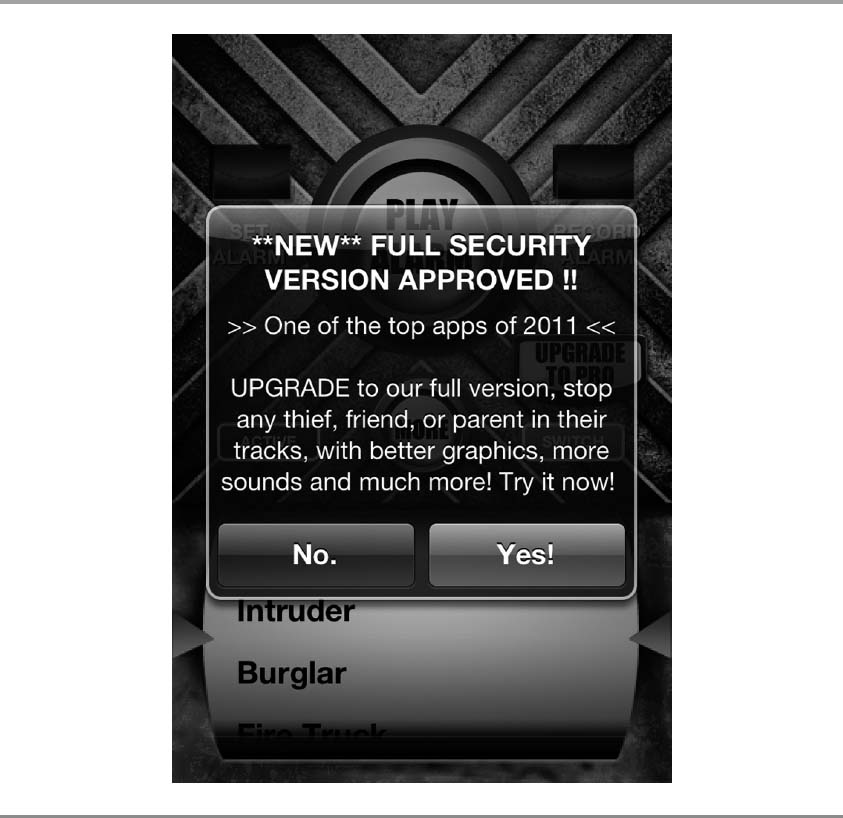
FIGURE 8.1 Nag screen example.
Nag screens have two styles. One is the default blue nag screen, which looks like all the other alerts you get on your phone. This version is easy to implement and good for getting started. When you generate more revenue, you can move to a better looking nag screen, one that fills the screen and is graphically more engaging (see Figure 8.2). On average, these advanced nag screens receive about three times more click-throughs than the default ones.
Nag screens have been the most critical advanced marketing strategy for my business. You have to utilize them. You might think, “I don't want to annoy my users with these ads,” and that is a valid thought, but think of this as adding value for users. If they have downloaded your free app and are using it, you have users who are interested in your apps and in that type of app. They might want to get the pro version with the additional features. For those who don't, a quick pop-up message is a small price to pay for using your free app.
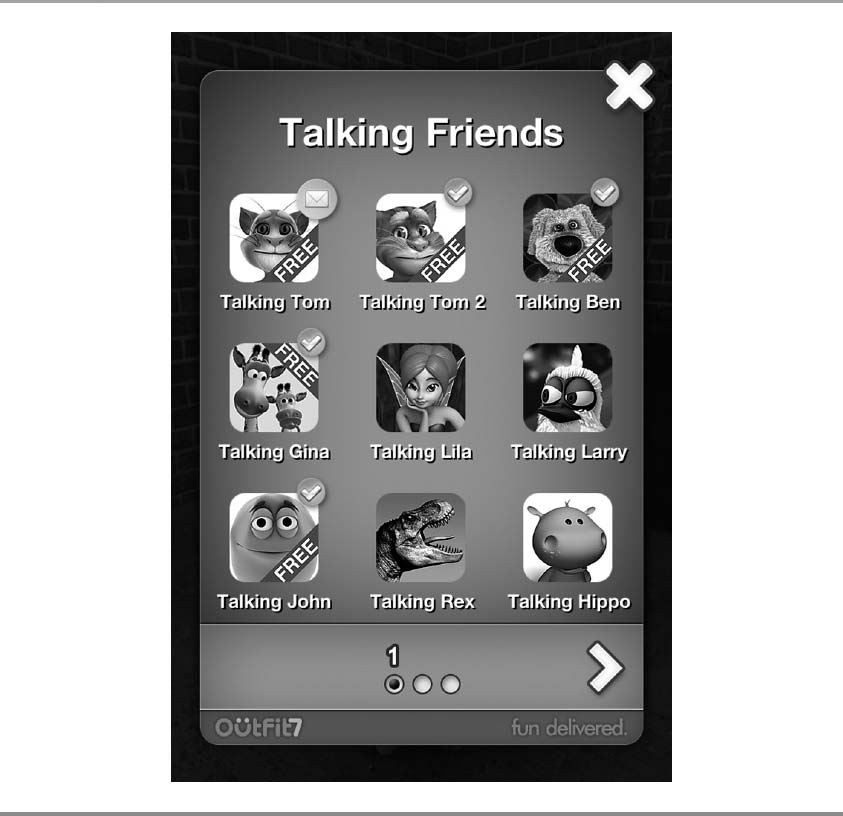
FIGURE 8.2 Advanced nag screen.
You have to accept this and not shy away from this type of marketing. If you're still on the fence, consider this: When Apple launched its iBooks app, it used a nag screen within the App Store app. If you had an iPhone at the time, you may remember seeing that pop-up inviting you to download iBooks. Well, you were nagged by the one and only Apple.
With my free Phone Security app, I was getting around 30,000 downloads a day without generating much revenue. To address this, I added a nag screen to get consumers to upgrade to the pro version. This added around $650 a day immediately. I was converting about 3 percent of the daily free traffic into sales of my paid app. This had such a profound effect that my paid ranking moved up the rankings from 280 to 26, which created more visibility and, ultimately, sales. This upward positive spiral was all fueled by the nag screen on my free app. This is the power of the app network.
When adding a nag screen, explain to your developer what you are looking for, and reference specific examples of other apps that have nag screens. Be sure you can change the nag screen without submitting a new update to the app store. To do this, tell the developer you want your nag screen to be dynamic. That way you can change the marketing message and the app you're advertising at any time. This will allow you to redirect your app network traffic within seconds. This is an absolute must. Your nag screens will lose a huge part of their effectiveness if you cannot change them on the fly.
For this to happen, the developer must implement something called a server-client interaction so every time the app launches, it checks in with the server and gets the latest version of the nag screen. You'll be able to edit your nag screen on the server, and your app will show the new version of your nag screen. Your developer should be able to understand this concept and create the dynamic nag screens you're looking for. You also need to be able to turn off your nag screens and turn them back on.
Keep your nag screens simple, short, and benefit-oriented. The amount of space you have is limited. Maximize the impact of your message by focusing on the benefits of the app you're promoting. It's crucial to include a call to action as well as seen in Figure 8.1.
How do you assess the effectiveness of your nag screen? All you have to do is keep track of how many times you show a particular nag screen as opposed to how many of those users click on “yes” to check out the app you're promoting. This is called your click-through rate, and the higher the percentage the better.
Special promotions usually receive higher click-through rates. “Upgrade now before the price goes back up” or “Free only for a few days so get it now” are useful calls to action. You should test and change your nag screen message on a regular basis to see if can get better click-through rates. Track all of this activity with Flurry so you can make informed decisions on what nag screen copy converts the best.
Add nag screens to all of your apps, even the paid ones. You should not turn on the nag screens of your paid apps because that will really annoy your users. But you never know when you might decide to make one of your paid apps free for a certain amount of time. You want to have the freedom to turn that app's nag screen on and direct its traffic to another app in your app network, especially if it takes off and starts generating lots of traffic. If you don't, you could lose out on a lot of money.
PROMO PAGES
If the nag screen is your most important cross-promotion tool, your promo page will be your second most important (see Figure 8.3). Unlike the nag screen, you can cross-promote more than one app at a time, and that is the power of the promo page. This is essentially a section of your app that lists all of your other apps and the apps of the developers with whom you're cross-promoting.
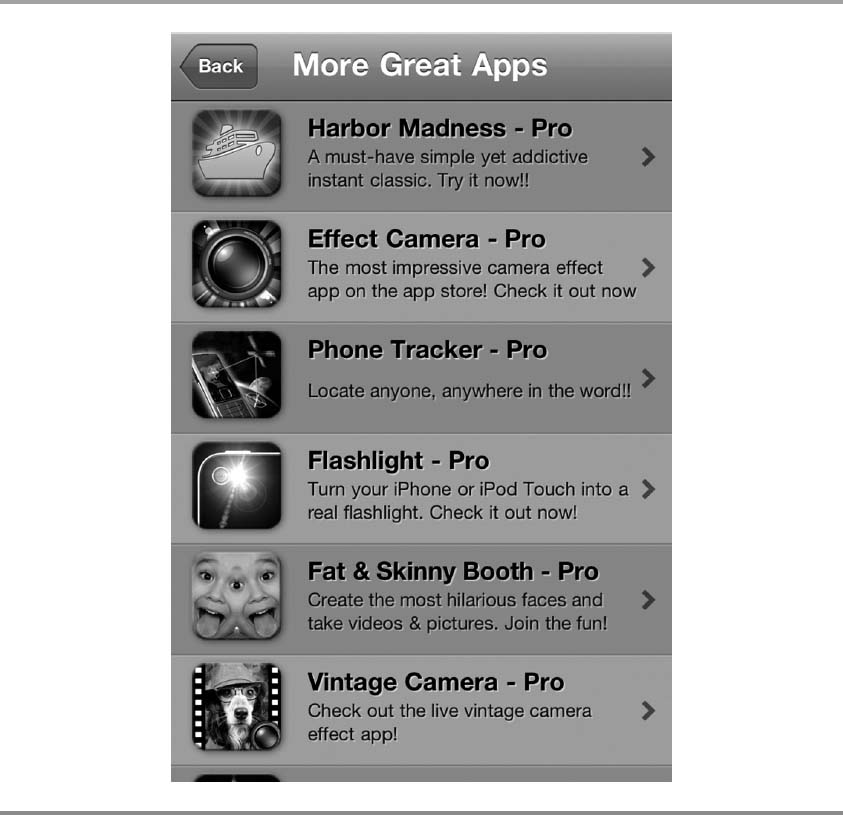
FIGURE 8.3 Promo page example.
The promo page example shows several apps covering the entire page. Users are able to scroll down to see more listed apps. Keep this page simple like the nag screen. Only include the icon, title, and a short description of the apps that you are promoting. Make sure your short description is enticing, and avoid clutter at all costs. You need to have an arrow at the right side of each app. This shows users they will get more information when they touch the banner, and it's a subtle call to action.
Each one of those banners links to the promoted app. When users touch the banner, they are taken to the App Store to review and download that app. This is a powerful tool to further increase sales. I've tested several color schemes for the promo page and have found that the bright gray and dark gray banner background color scheme of the App Store works best. I recommend you do the same if you want to maximize the click-through rates of your promo pages.
Each one of the banner positions of your promo page will be worth a certain amount of money based on the daily traffic of your app. The higher the banner position, the more money it is worth because it gets more visibility and thus users click on it more often. For example, if one of your apps is getting 10,000 downloads a day, you can assume that a certain number of your users will enter your promo page. Let's say 25 percent of the 10,000, which is 2,500 users. If you can generate sales from only 10 percent of those users who have entered your promo page, you will have another 250 sales, which is about $175. And that's from the promo page of only one of your apps.
You might wonder how to direct people to the promo pages in your apps. Every one of your apps needs to have a button with the word “More” on it prominently displayed in the main page or menu section inside of your app. (See Figures 8.4 and 8.5.) That's all. I've tested many other promo button labels like “More apps,” “I,” or “+,” but “More” had the greatest click-through rates. When users hit the more button, they are taken to my promo page, which has a back button to return them to where they were before.
Your More button must be highly visible. One way to do this is to give it some bright color or a glow effect to draw your users' attention. You might think you don't want to be too aggressive with your advertising, but remember the nag screen discussion above. You have to get some traffic on your promo page so you can show your users all the other cool apps that you or others have created.
FIGURE 8.4 Example of a More button.
Some developers decide to be more subtle and place the promo page button hidden somewhere where users have to move through several pages to see it. Another issue is that the promo page button sometimes blends in too much and doesn't grab the users' attention. If you're going to do that, then you might as well not have a promo page because you will be diminishing its effect. Your users must see it as soon as they open the app.
The reason why it's so important to get a lot of traffic to your promo page is because, along with the nag screen, your promo page is where all your app network magic happens. Each banner that's linking to another one of your apps in your promo page is creating a link between those two apps. The sum of these links will make up your app network. So, link away, my fellow appreneur.
FIGURE 8.5 Another example of a More button.
How do you set up a promo page? The concept is similar to the nag screen. Whoever sets up your nag screen should create your promo pages, so you'll have an integrated system.
Your promo page will be a useful tool to cross-promote with other developers. The reason you want to cross-promote with others is this can increase the number of people who see your apps. Your apps will be visible to your own app network and to the app network of the developers you're cross-promoting with. How do you do it? Throw their apps on your promo pages and ask them to do the same for you. Instant traffic boost.
The concept of cross-promotion is not unique to the app business. In real estate, every agent is taught at the beginning of their career to network with people who provide services for the home buying process. For example, you build relationships with mortgage brokers, and they send you people looking for houses. In return, you send them people looking for loans.
With Alan, I immediately saw how this applied to the app world and decided to cross-promote my apps with him. But I didn't stop there. I got in touch with other entertainment app companies including Lima Sky, the creators of Doodle Jump. It was great timing because they were releasing their new Bubble Wrap app. I was able to get them to cross-promote with me and this increased the amount of traffic to my app network.
If you model this strategy with several developers, instead of one, you have the potential of seeing your traffic skyrocket. Find developers whose apps have similar amounts of traffic and similar demographics to your own and maximize your conversion rate. Utility apps, for example, will not cross-promote as well to games as they do to other utility apps because the demographic differs.
PUSH NOTIFICATIONS
Push notifications are another effective advanced marketing tactic. A push notification sends a message to customers who have your app on their phone. The notification can contain whatever message you want to pass on to the user. It pops up on the screen like a text message, requiring the user to discard the message or to open the app that has sent it. The ingenuity of push notifications is that you're reminding users of your app and giving them the option to open it up with a touch of the screen.
Since these notifications are displayed like text messages, the open rate is close to 100 percent. After all, have you ever not read a text message that popped up on your screen? That's huge for marketing your app and untouched by any other type of advertising in any industry.
Push notifications are a powerful in-your-face way of marketing your app and have to be used tactfully. Don't send push notifications every day because customers will get annoyed and delete your app. It's one thing to show them some advertising when they are actively engaged with one of your apps, but it's different to send them a push notification, interrupting whatever else they may be doing at that time.
This strategy works best after you've built a solid fan base that is excited to use your apps or to see what your next update will be. The company Outfit7, with their hugely successful Talking Tom and other “talking apps,” do a great job with this. They rarely send push notifications and when they do it's something fun like “I miss you” or “Come play with me.” Sometimes they also advertise a new feature.
Let's consider the financial impact of push notifications. Assume you have an app that has an active user base of 250,000. If you send out a push notification and only 10 percent of your users check it out, you will have infused your app network with an additional 25,000 users for that particular day. That traffic will increase your revenue through additional sales, banner clicks, and affiliate income. It's like printing money with the click of button.
YOUR DEVELOPER NETWORK
A few months after its release, my top app started dropping in the rankings, and I didn't know how to stop it. I asked myself: “What can I do to make this a sustainable business rather than a one-hit wonder?” So, I thought, “Whom do I know in this business who can help me? Who can be a mentor? Who can I model for success?” That was what I had always thought of when I wanted to take things to the next level.
The reality was that I didn't know anybody in the business. The app industry was so new at the time that most developers were concentrated in Silicon Valley, so that's where I decided to go. I landed in San Francisco with everything I owned in two bags. I was dedicated, ready to network and start my life as an appreneur. My cross-country move propelled my business to new heights. The first contact I made was Alan, and from there my developer network took off. I networked with other appreneurs and learned the strategies they were using to monetize their apps. I never would have thought of some of these on my own.
You don't have to uproot your life and move to San Francisco to network since developers are everywhere and you can leverage technology. But your success depends on finding like-minded people to network with. Learning from somebody who's doing well can help you make progress faster than figuring out the ins and outs of the business yourself.
Where can you find them? Use Meetup (appempire.com/meetup) or similar networking sites, industry conferences, developer blogs, and so on. Meetup connects you with people in similar industries or with similar hobbies. At the first iPhone developer meet-up I went to, I met a few great developers, and they introduced me to their developer friends. We created a mastermind group that became pivotal to our success. They taught me their skills, and I was able to show them a few things to help them take their businesses to the next level.
Motivated by the results of the mastermind group, I attended app conferences and grew my developer network. These conferences are a networker's dream, allowing appreneurs to learn new, useful information and meet like-minded people. One time, I went to the BizTech conference, where Internet marketing expert and app developer Joel Comm was speaking. At the end of his speech, I asked Mr. Comm a question and began by introducing myself and plugging my app in front of a large crowd of attendees.
Afterward, several people came over to me and said, “I'm an app developer, too.” It was a great way to meet people, but I had to put myself out there first.
The good news is that you don't have to get up and talk in front of a crowd of hundreds to network successfully. When you attend meet-ups and technology conferences, introduce yourself to people one at a time and ask questions to find out more. Ask where they are from, what they do, and so on. Everybody is there to learn and meet others so you don't need to be shy. For every conference you go to, make it your goal to bring one person into your “inner circle.” Before you know it, you'll have a dream team appreneur network.
Another good way to connect and learn from other developers is developer blogs. Now that the app industry is growing in leaps and bounds, many developers are creating blogs to talk about their successes. I recommend checking them out and contacting a few. Make comments on their blogs and ask questions. You can contact other people who post comments on their sites to see what they are working on. It's another opportunity to network and share ideas. A single new connection can lead to an influx of revenue for your business and, who knows, a new friendship.
Work on your developer network as much as you're working on your app network.
UPDATES
Guess what. There is no such thing as a finished app. You'll be fixing bugs, adding new features, or responding to competition on a consistent basis. To get the newest version of your app to your users, all you have to do is upload it to Apple for review, much like the first time you publish your app. After Apple's approval, all users who have your app installed on their device will see that an update is available (see Figure 8.6). This seems simple and obvious but updates are a huge marketing opportunity.
FIGURE 8.6 App updates on the App Store app.
When you push out an update, a portion of your users will download this new version of your app. Based on your user base, the number of people downloading your update could surpass your regular daily traffic. I've seen many updates that increased my daily traffic by 5 to 10 times. So, if you have 10,000 downloads per day, your update could add 50,000 to 100,000 additional downloads that day. These will not count for your ranking and not every user opens up your app after an update, but your daily traffic can double even if a small percentage of users decides to check out your update. This will cause a spike in your income and remind the users about your app.
Update frequently for any reason you can think of. Don't wait to for your programmer to add 10 features to submit and update. It's better to submit 10 updates, one for each feature as you build them out. Your users won't mind and will get the impression you are constantly improving your app. I consider updates free advertising because you capture a percentage of the users who download the update to see what features have been added.
So, keep in mind: Updates = Dollars.
PAID TRAFFIC
Another advanced strategy you can use is to pay for traffic to grow your app network quickly. A few companies have specialized in getting massive amounts of traffic for your apps. Some of the big names are FreeAppADay (appempire.com/freeappaday) and TapJoy (appempire.com/tapjoy). FreeAppADay will promote your app to its large user database if you offer your paid app free for a limited time. You pay a fee to the company for the traffic it sends you. I used it to promote my Alarm Security app, which had been ranked number 180 in the utilities category and was getting about 1,000 downloads a day. I spent $2,500 to get the FreeAppADay traffic. The app shot up in the rankings to number 17 overall, increasing the traffic to about 40,000 a day. This helped me to grow my app network and increase my overall income. As the app world grows, look for more and more of these companies to pop up. Only use this strategy if it makes economic sense, but exhaust all of the free tactics first.
Now that you have learned how to build your app network, let's find out how to squeeze the most amount of dollars from it in the next chapter.
What I Learned
1.
2.
3.
Actions to Take
- Add nag screens to your app.
- Add more buttons and promo pages to cross-promote your apps.
- Add push notifications to your apps.
- Network with other app developers on a regular basis.
- Update your apps on a regular basis.
- Consider paid options to grow your app network.

